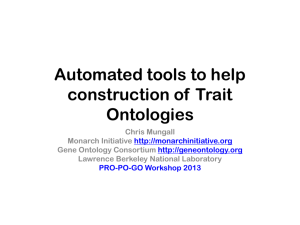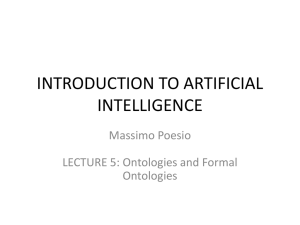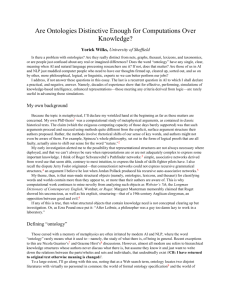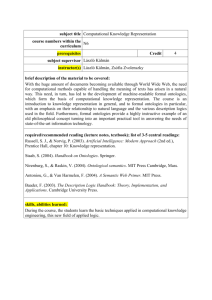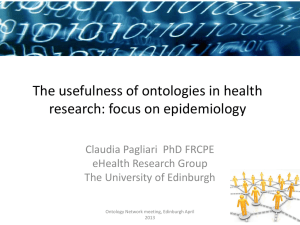ISWC-Tutorial-Best-practice
advertisement
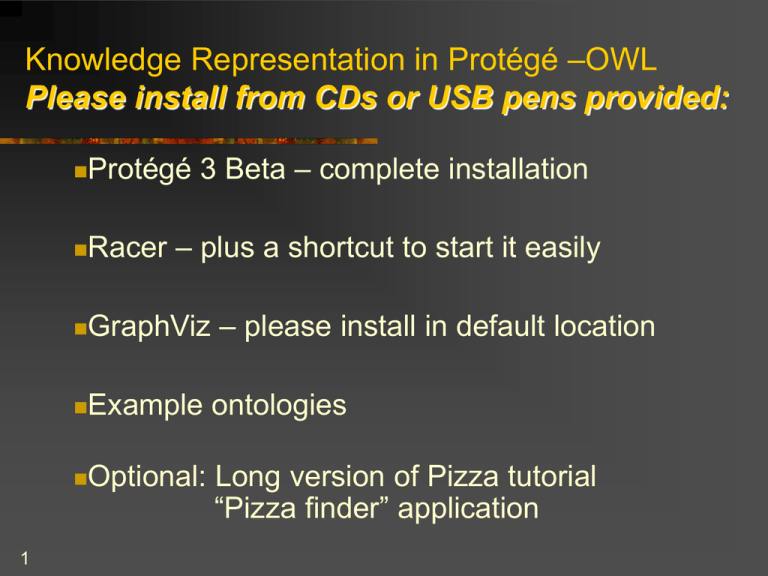
Knowledge Representation in Protégé –OWL
Please install from CDs or USB pens provided:
Protégé
Racer
3 Beta – complete installation
– plus a shortcut to start it easily
GraphViz
1
– please install in default location
Example
ontologies
Optional:
Long version of Pizza tutorial
“Pizza finder” application
Ontology Design Patterns and Problems:
Practical Ontology Engineering using
Protege-OWL
Alan Rector1, Natasha Noy2, Holger Knublauch2,
Guus Schreiber,3 Mark Musen2
1University
of Manchester
2Stanford University
3 Free University of Amsterdam
2
rector@cs.man.ac.uk
{noy, holger}@smi.stanford.edu
schreiber@cs.vu.nl
musen@smi.stanford.edu
Program
I Ontologies and “Best Practice”
II Creating an ontology – useful patterns
III Hands on examples
IV Patterns: n-ary relations
V Patterns: classes as values
VI Patterns: part-whole relations
VII Summary
3
Part I: Ontologies & “Best
Practice”
What are Ontologies & a review of
History
Semantic Web
OWL
“Best Practice”
4
Semantic Web Best Practice &
Deployment Working Group (SWBP)
What Is An Ontology?
Ontology (Socrates & Aristotle 400-360 BC)
The study of being
Word borrowed by computing for the
explicit description of the conceptualisation of a domain:
An ontology defines
5
concepts
properties and attributes of concepts
constraints on properties and attributes
Individuals (often, but not always)
a common vocabulary
a shared understanding
Why Develop an Ontology?
To share common understanding of the
structure of descriptive information
To enable reuse of domain knowledge
6
among people
among software agents
between people and software
to avoid “re-inventing the wheel”
to introduce standards to allow interoperability
Measure the world…quantitative models
(not ontologies)
Quantitative
Numerical data:
Unambiguous tokens
Main problem is accuracy at initial capture
Numerical analysis (e.g. statistics) well
understood
Examples:
7
2mm, 2.4V, between 4 and 5 feet
How big is this breast lump?
What is the average age of patients with
cancer ?
How much time elapsed between original
referral and first appointment at the hospital ?
describe the our understanding of
the world - ontologies
Qualitative
Descriptive data
Cold, colder, blueish, not pink, drunk
Ambiguous tokens
What’s wrong with being drunk ?
Accuracy poorly defined
Automated analysis or aggregation is a new science
Examples
8
Ask a glass of water.
Which animals are dangerous ?
What is their coat like?
What do animals eat ?
More Reasons
To make domain assumptions explicit
easier to change domain assumptions (consider a
genetics knowledge base)
easier to understand and update legacy data
To separate domain knowledge from the
operational knowledge
9
re-use domain and operational knowledge
separately (e.g., configuration based on
constraints)
To manage the combinatorial explosion
An Ontology should be just the
Beginning
Ontologies
Provide
domain
description
Software
agents
10
Problemsolving
methods
Declare
structure
The
“Semantic
Web”
Domainindependent
applications
Databases
Knowledge
bases
Outline
What are Ontologies
Semantic Web
OWL
Best Practice
11
The semantic web
Tim Berners-Lee’s dream of a computable
meaningful web
Now critical to Web Services and Grid
computing
Metadata with everything
Machine understandable!
12
Ontologies are one of the keys
Understanding rather than text matching
13
Google image results for
Charlie Safran
Mark Musen
Alan Rector
Ontology Examples
Taxonomies on the Web
Catalogs for on-line shopping
Amazon.com product catalog
Dublin Core and other standards for the Web
Domain independent examples
14
Yahoo! categories
Ontoclean
Sumo
Ontology Technology
“Ontology” covers a range of things
Controlled vocabularies – e.g. MeSH
15
Linguistic structures – e.g. WordNet
Hierarchies (with bells and whistles) – e.g. Gene
Ontology
Frame representations – e.g. FMA
Description logic formalisms – Snomed-CT,
GALEN, OWL-DL based ontologies
Philosophically inspired e.g. Ontoclean and SUMO
Outline
What are Ontologies
Semantic Web
OWL
Best Practice
16
OWL
The Web Ontology Language
W3C standard
Collision of DAML (frames) and Oil (DLs in Frame
clothing)
Three ‘flavours’
OWL-Lite –simple but limited
OWL-DL – complex but deliverable (real soon now)
OWL-Full – fully expressive but serious logical/computational
problems
17
Russel Paradox etc etc
All layered (awkwardly) on RDF Schema
Still work in progress – see Semantic Web Best
Practices & Deployment Working Group (SWBP)
Note on syntaxes for OWL
Three official syntaxes + Protégé-OWL syntax
18
XML/RDF
Protégé-OWL
-Specific to OWL
-OWL & RDF
-used in all SWBP documents
-very verbose
-Compact, derived from DL syntax
This tutorial uses simplified abstract syntax
Abstract syntax
N3
someValuesFrom
allValuesFrom
intersectionOf
unionOf
complementOf
some
only
AND
OR
not
Protégé/OWL can generate all syntaxes
A simple ontology: Animals
Living Thing
Body Part
eats
has part
Plant
Arm
Animal
Leg
eats
eats
Grass
Herbivore
Tree
Person
Carnivore
Cow
19
Description Logics
What the logicians made of Frames
Greater expressivity and semantic precision
Compositional definitions
To allow automatic classification & consistency
checking
The mathematics of classification is tricky
Some seriously counter-intuitive results
20
“Conceptual Lego” – define new concepts from old
The basics are simple – devil in the detail
Description Logics
Underneath:
computationally tractable subsets of first order logic
Describes relations between
Concepts/Classes
Individuals secondary
21
DL Ontologies are NOT databases!
Description Logics:
A brief history
Informal Semantic Networks and Frames (pre 1980)
First Formalisation (1980)
Brachman & Levesque: A fundamental tradeoff
Hybrid systems: T-Box and A-Box
All tractable systems are useless (1987-1990)
22
Bobrow KRL, Brachman: KL-ONE
All useful systems are intractable (1983)
Wood: What’s in a Link; Brachman What IS-A is and IS-A isn’t.
Doyle and Patel: Two dogmas of Knowledge Representation
A brief history of KR
‘Maverick’ incomplete/intractable logic systems (1985-90)
Practical knowledge management systems based on frames
GRAIL, LOOM, Cyc, Apelon, …,
Protégé
The German School: Description Logics (1988-98)
Complete decidable algorithms using tableaux methods (1991-1992)
Detailed catalogue of complexity of family – “alphabet soup of systems”
Optimised systems for practical cases (1996-)
Emergence of the Semantic Web
23
Development of DAML (frames), OIL (DLs) DAML+OIL OWL
Development of Protégé-OWL
A dynamic field – constant new developments & possibilities
Outline
What are Ontologies
Semantic Web
OWL
“Best Practice”
24
Semantic Web Best Practice & Deployment
Working Group (SWBP)
Why the
“Best Practice working Group”?
There is no established “best practice”
It is new; We are all learning
A place to gather experience
A catalogue of things that work –
Analogue of Software Patterns
Some pitfalls to avoid
…but
Learning to build ontologies
Too many choices
25
there is no one way
Need starting points for gaining experience
Provide requirements for tool builders
Contributing to “best practice”
Please give us feedback
Your questions and experience
On the SW in general:
semanticweb@yahoogroups.com
For specific feedback to SWBP
26
Home & Mail Archive:
http://www.w3.org/2001/sw/BestPractices/
public-swbp-wg@w3.org
Protégé OWL: New tools for
ontologies
27
Transatlantic collaboration
Implement robust OWL environment
within PROTÉGÉ framework
Shared UI
components
Enables hybrid
working
Protégé-OWL & CO-ODE
Joint work: Stanford & U Manchester +
Southampton & Epistemics
Please give us feedback on tools – mailing lists & forums at:
protege.stanford.edu
www.co-ode.org
Don’t beat your head against a brick wall!
Look to see if others have had the same problem; If not…
ASK!
28
We are all learning.
Part II – Creating an ontology
Useful patterns
29
Upper ontologies & Domain ontologies
Building from trees and untangling
Using a classifier
Closure axioms
Specifying Values
n-ary relations
Classes as values – using the ontology
Part-whole relations
Upper Ontologies
Ontology Schemas
High level abstractions to constrain
construction
e.g. There are “Objects” & “Processes”
Highly controversial
Sumo, Dolce, Onions, GALEN, SBU,…
Needed when you work with many people
together
NOT in this tutorial – a different tutorial
30
Domain Ontologies
Concepts specific to a field
Diseases, animals, food, art work, languages, …
The place to start
Understand ontologies from the bottom up
Levels
Top domain ontologies – the starting points for the field
Living Things, Geographic Region, Geographic_feature
Domain ontologies – the concepts in the field
31
Or middle out
Cat, Country, Mountain
Instances – the things in the world
Felix the cat, Japan, Mt Fuji
Part II – Useful Patterns
(continued)
32
Upper ontologies & Domain ontologies
Building from trees and untangling
Using a classifier
Closure axioms & Open World Reasoning
Specifying Values
n-ary relations
Classes as values – using the ontology
Example: Animals & Plants
Dog
Cat
Cow
Person
Tree
Grass
Herbivore
Male
Female
Carnivore
Plant
Animal
Fur
Child
Parent
Mother
Father
33
Dangerous
Pet
Domestic
Animal
Farm animal
Draft animal
Food animal
Fish
Carp
Goldfish
Example: Animals & Plants
34
Dog
Cat
Cow
Person
Tree
Grass
Herbivore
Male
Female
Carnivore
Plant
Animal
Fur
Child
Parent
Mother
Father
Healthy
Pet
Domestic
Animal
Farm animal
Draft animal
Food animal
Fish
Carp
Goldfish
Choose some main axes
Add abstractions where needed; identify relations;
Identify definable things, make names explicit
Living Thing
Animal
Cat
Dog
Cow
Person
Carp
Goldfish
Tree
Grass
Fruit
healthy
sick
Sex
Draft
Food
Wild
Health
Relations
eats
owns
parent-of
…
Definable
pet
Farmed
domestic
Plant
35
Fish
Modifiers
Mammal
Male
Female
Age
Adult
Child
Carinvore
Herbivore
Child
Parent
Mother
Father
Food Animal
Draft Animal
Reorganise everything but “definable” things into
pure trees – these will be the “primitives”
Primitives
Living Thing
Animal
Mammal
Cat
Dog
Cow
Person
Domestic
Wild
Plant
Tree
Grass
Fruit
Dangerous
Safe
Sex
Draft
Food
pet
Risk
Carp
Goldfish
Relations
eats
owns
parent-of
…
Definables
Use
Domestication
Fish
36
Modifiers
Male
Female
Age
Adult
Child
Carnivore
Herbivore
Child
Parent
Mother
Father
Food Animal
Draft Animal
Set domain and range constraints
for properties
Animal eats Living_thing
Person owns Living_thing except person
owns domain: Person
range: Living_thing & not Person
Living_thing parent_of Living_thing
37
eats domain: Animal;
range: Living_thing
parent_of: domain: Animal
range: Animal
Define the things that are definable
from the primitives and relations
38
Parent =
Animal and parent_of some Animal
Herbivore=
Animal and eats only Plant
Carnivore =
Animal and eats only Animal
Which properties can be filled in
at the class level now?
What can we say about all members of a
class
eats is the only one
All cows eat some plants
All cats eat some animals
All dogs eat some animals &
eat some plants
39
Fill in the details
(can use property matrix wizard)
40
Check with classifier
Cows should be Herbivores
Are they? why not?
What have we said?
What do we need to say:
Closure axiom
41
Cows are animals and, amongst other things,
eat some grass and
eat some leafy_plants
Cows are animals and, amongst other things,
eat some plants and eat only plants
Closure Axiom
Cows are animals and, amongst other things,
eat some plants and eat only plants
Closure
Axiom
42
In the tool
Right mouse
button short cut
for closure
axioms
43
for any existential
restriction
Open vs Closed World reasoning
Open world reasoning
Negation as contradiction
Anything might be true unless it can be proven
false
Closed world reasoning
Negation as failure
Anything that cannot be found is false
44
Reasoning about any world consistent with this one
Reasoning about this world
Normalisation and Untangling
Let the reasoner do multiple classification
Tree
Everything has just one parent
Directed Acyclic Graph (DAG)
Things can have multiple parents
A ‘Polyhierarchy’
Normalisation
Separate primitives into disjoint trees
Link the trees with restrictions
45
A ‘strict hierarchy’
Fill in the values
Tables are easier to manage than
DAGs / Polyhierarchies
…and get the benefit of inference:
Grass and Leafy_plants are both kinds of Plant
46
Remember to add any closure
axioms
Closure
Axiom
Then let the reasoner do the work
47
Normalisation:
From Trees to DAGs
Before classification
A tree
After classification
A DAG
48
Directed Acyclic Graph
Part II – Useful Patterns
(continued)
49
Upper ontologies & Domain ontologies
Building from trees and untangling
Using a classifier
Closure axioms & Open World Reasoning
Specifying Values
n-ary relations
Classes as values – using the ontology
Examine the modifier list
Modifiers
Domestication
Domestic
Wild
Dangerous
Safe
Male
Female
Age
50
Draft
Food
Adult
Child
Domestication
Risk
Sex
Age
Make meaning precise
Sex
Risk
Identify modifiers that are
mutually exclusive
Use
Age Age_group
NB Uses are not mutually
exclusive
Can be both a draft and a food
animal
Extend and complete lists of
values
Modifiers
Domestication
Domestic
Wild
Feral
51
Sex
Dangerous
Risky
Safe
Adult
Elderly
Domestication
Risk
Sex
Age
Make meaning precise
Male
Female
Age
Infant
Toddler
Child
Identify modifiers that are
mutually exclusive
Risk
Age Age_group
NB Uses are not mutually
exclusive
Can be both a draft and a food
animal
Note any hierarchies of values
Modifiers
Domestication
Domestic
Wild
Feral
Dangerous
Risky
Safe
Child
Infant
Toddler
Adult
Elderly
Domestication
Risk
Sex
Age
Make meaning precise
Male
Female
Age
52
Sex
Risk
Identify modifiers that are
mutually exclusive
Age Age_group
NB Uses are not mutually
exclusive
Can be both a draft and a food
animal
Specify Values for each
Value partitions
Classes that partition a Quality
Symbolic values
Individuals that enumerate all states of a Quality
53
The disjunction of the partition classes equals the
quality class
The enumeration of the values equals the quality
class
Value Partitions: example
Dangerousness
A parent quality – Dangerousness
Subqualities for each degree
All subqualities disjoint
Subqualities ‘cover’ parent quality
Dangerous, Risky, Safe
Dangerousness = Dangerous OR Risky OR Safe
A functional property has_dangerousness
Range is parent quality, e.g. Dangerousness
Domain must be specified separately
Dangerous_animal =
Animal and has_dangerousness some Dangerous
54
as created by Value Partition
wizard
55
Value partitions
Diagram
Animal
Risky
Dangerous
Dangerousness
Leo’s
Danger
Safe
56
Dangerous
animal
Leo the
Lion
Value partitions UML style
Animal
Dangerousness_
Value
owl:unionOf
Safe_
value
Risky_
value
Dangerous_
value
Leo’s
Dangerousness
57
has_dangerousness Dangerous
someValuesFrom
Animal
has_dangerousness
Leo the
Lion
Values as individuals:
Example Sex
There are only two sexes
Can argue that they are things
“Administrative sex” definitely a thing
“Biological sex” is more complicated
58
Value sets for specifying values
A parent quality – Sex_value
Individuals for each value
Values all different (NOT assumed by OWL)
Value type is enumeration of values
59
Sex_value = {male, female}
A functional property has_sex
male, female
Range is parent quality, e.g. Sex_value
Domain must be specified separately
Male_animal =
Animal and has_sex is Dangerous
Value sets UML style
Person
Sex
Value
owl:oneOf
has_sex
female
male
Man
John
60
Issues in specifying values
Value Partitions
Can be subdivided and specialised
Fit with philosophical notion of a quality space
Require interpretation to go in databases as values
Work better with existing classifiers in OWL-DL
Value Sets
61
in theory but rarely considered in practice
Cannot be subdivided
Fit with intuitions
More similar to data bases – no interpretation
Work less well with existing classifiers
Value partitions – practical
reasons for subdivisions
“All elderly are adults”
“All infants are children”
etc.
See also “Normality_status” in
http://www.cs.man.ac.uk/~rector/ontologies/mini-top-bio
62
One can have complicated value partitions if needed.
Picture of subdivided value
partition
Elderly_
value
Adult_value
Infant_
value
Toddler_
value
Child_value
Age_Group_value
63
More defined kinds of animals
64
Before classification, trees
After classification, DAGs
Part III – Hands On
Be sure you have installed the software
65
(See front page)
Open Animals-tutorial-step-1
Explore the interface
66
Protégé Syntax
67
Explore the interface
New Subclass
icon
Asserted
Hierarchy
Class
Description
Disjoint
Classes
68
Explore the interface
New
restriction
Add
superclass
New
expression
Description
“Necessary
Conditions”
69
Explore the interface
Definition
“Necessary
&
Sufficient
Conditions”
“Defined class”
(orange/red circle)
70
Explore the interface
Classify button
(racer must be running
71
Exercise 1
Create a new animal, a Elephant and a
Ape
Make them disjoint from the other animals
Make the ape an omnivore
Make the sheep a herbivore
72
eats animals and plants
eats plants and only plants
Exercise 1b: Classification
Check it with the classifier
Is Sheep classified under Herbivore
Did it all turn red?
73
If not, have you forgot the closure axiom?
Do you have too many disjoint axioms?
Exercise 1c: checking disjoints –
make things that should be inconsistent
Create a Probe_Sheep_and_Cow that is
a kind of both Sheep and Cow
Create a Probe_Ape_and_Man that is a
kind of both Ape and Man
Run the classifier
Did both probes turn red?
74
If not, check the disjoints
Exercise 2: A new value partition
Create a new value partition
Size_partition
Big
Medium
Small
Describe
75
Lions, Cows, and Elephants as Big
domestic_cat as
Small
the rest
Medium
Exercise 2b
Define Big_animal and Small_animal
Does the classification work
Extra
Make a subdivision of Big for Huge and make
elephants Huge
76
Do elephants still classify as “Big Animal
Part IV – Patterns: n-ary relations
77
Upper ontologies & Domain ontologies
Building from trees and untangling
Using a classifier
Closure axioms & Open World Reasoning
Specifying Values
n-ary relations
Classes as values – using the ontology
Saying something about a
restriction
Not just
that an animal is dangerous,
but why
And how dangerous
And how to avoid
But can say nothing about properties
except special thing
78
Super and subproperties
Functional, transitive, symmetric
Re-representing properties as
classes
To say something about a property it must be
re-represented as a class
property:has_danger Class: Danger
Sometimes called “reification”
79
plus property: Thing has_quality Danger
plus properties: Danger has_reason
has_risk
has_avoidance_measure
But “reification” is used differently in different
communities
Re-representing the property has_danger as
the class Risk
Animal
has_danger
Dangerous
Risk_type
Animal
has_Quality
Risk
has_seriousness
Seriousness
Avoidance
80
Lions are dangerous
All lions pose a deadly risk of physical attack
that can be avoided by physical separation
All lions have the quality risk that is
81
of type some physical attack
of seriousness some deadly
has avoidance means some physical separation
Can add a second definition of
Dangerous Animal
A dangerous animal is any animal that has the
quality Risk that is Deadly
82
or
Dangerous_animal =
Animal
has_quality some
(Risk AND has_seriousness some Deadly )
[NB: “that” paraphrases as “AND”]
In the tool
Dangerous_animal =
83
Animal
has_quality some
(Risk AND has_seriousness some Deadly )
This says that
Any animal that is Dangerous
is also
An animal that has the quality
Dangerousness with the seriousness Deadly
84
Anopheles Mosquitos now count
as dangerous
85
Because they have a deadly risk of carrying
disease
Multiple definitions are dangerous
86
Better to use one way or the other
Otherwise keeping the two ways consistent is
difficult
… but ontologies often evolve so that
simple Properties are re-represented
as Qualities
Often have to re-analyse
What do we mean by “Dangerous”
How serious the danger?
How probable the danger?
Whether from individuals (Lions) or the
presence or many (Mosquitos)?
Moves to serious questions of “ontology”
The information we really want to convey
Often a sign that we have gone to far
87
So we will stop
88
Part V – Patterns: Classes as
values
89
Upper ontologies & Domain ontologies
Building from trees and untangling
Using a classifier
Closure axioms & Open World Reasoning
Specifying Values
n-ary relations
Classes as values – using the ontology
Part-whole relations
Using Classes as Property Values
dc:subject
subject
Animal
Lion
African
Lion
90
Tiger
Using Classes Directly As Values
Animal
BookAboutAnimals
rdfs:subclassOf
rdf:type
Lion
dc:subject
rdfs:subclassOf
African
Lion
91
"Lions:
Life in the Pride"
dc:subject
rdf:type
”The African
Lion"
Representation in Protégé
92
Approach 1: Considerations
93
Compatible with OWL Full and RDF
Schema
Outside OWL DL
Approach 2: Hierarchy of
Subjects
Animal
BookAboutAnimals
rdfs:subclassOf
Lion
"Lions:
Life in the Pride"
rdfs:subclassOf
rdf:type
African
Lion
rdf:type
dc:subject
rdf:type
”The African
Lion"
LionSubject
dc:subject
rdf:type
AfricanLionSubject
94
Hierarchy of Subjects:
Considerations
Compatible with OWL DL
Lion
Instances of class Lion are now
rdf:type
subjects
rdfs:subclassOf
No direct relation between
LionSubject
LionSubject and
African
AfricalLionSubject
Lion
Maintenance penalty
rdf:type
AfricanLionSubject
95
Hierarchy of Subjects
Animal
Subject
BookAboutAnimals
rdfs:subclassOf
Lion
rdf:type
rdf:type
rdfs:seeAlso
dc:subject
rdfs:subclassOf
African
Lion
rdf:type
rdfs:seeAlso
LionSubject
parentSubject
AfricanLionSubject
96
"Lions:
Life in the Pride"
rdf:type
”The African
Lion"
dc:subject
Hierarchy of Subjects:
Considerations
Compatible with OWL DL
Lion
Subject hierarchy
(terminology) is
rdfs:subclassOf
independent of class
African
hierarchy (rdfs:seeAlso)
Lion
Maintenance penalty
rdfs:seeAlso
Subject
rdf:type
LionSubject
parentSubject
AfricanLionSubject
97
Using members of a class as
values
Animal
BookAboutAnimals
rdfs:subclassOf
rdf:type
"Lions:
Life in the Pride"
Lion
rdfs:subclassOf
dc:subject
rdf:type
African
Lion
Unidentified Lion(s)
”The African
Lion"
dc:subject
rdf:type
Unidentified African
Lion(s)
98
rdf:type
Representation in Protege
rdf:typ
e
Note: no subject value
99
Considerations
100
Compatible with OWL DL
Interpretation: the subject is one or more
specific lions, rather than the Lion class
Can use a DL reasoner to classify specific
books
Part VI – Patterns:
Part-whole relations
101
Upper ontologies & Domain ontologies
Building from trees and untangling
Using a classifier
Closure axioms & Open World Reasoning
Specifying Values
n-ary relations
Classes as values – using the ontology
Part-whole relations
Part-whole relations
One method: NOT a SWBP draft
How to represent part-whole relations in
OWL is a commonly asked question
SWBP will put out a draft.
This is one approach that will be
proposed
102
It has been used with classes
It has no official standing
It is presented for information only
Part Whole relations
OWL has no special constructs
But provides the building blocks
Transitive relations
Finger is_part_of Hand
Hand is_part_of Arm
Arm is_part_of Body
103
Finger is_part_of Body
Many kinds of part-whole
relations
Physical parts
Geographic regions
104
Hiroshima - Japan
Functional parts
hand-arm
cpu – computer
See Winston & Odell
Artale
Rosse
Simple version
One property is_part_of
transitive
105
finger is_part_of some Hand
Hand is_part_of some Arm
Arm is_part_of some Body
Get a simple list
Probe_part_of_body =
Domain_category
is_part_of some Body
Logically correct
But may not be what
we want to see
The finger is not a kind
of Hand
106
It is a part of the hand
Injuries, Faults, Diseases, Etc.
A hand is not a kind of a body
A motor is not a kind of automobile
107
… but an injury to a hand is a kind of injury to
a body
… but a fault in the motor is a kind of fault in
the automobile
And people often expect to see partonomy
hierarchies
Being more precise: “Adapted SEP
Triples”
Body (‘as a whole’)
The Body’s parts
Body OR is_part_of some body
Repeat for all parts
108
is_part_of some Body
The Body and it’s parts
Body
Use ‘Clone class’ or
NB: ‘JOT’ Python plugin is good for this
Adapted SEP triples:
UML like view
Injury to Arm
(or part of arm)
has_locus
some Arm OR part part of arm
Part of
Arm
Arm
Injury to Hand
109
has_locus
some
Hand
Forearm
Adapted SEP triples:
Venn style view
Arm
Arm or parts of Arm
Parts of Arm
Fore
Arm
110
Hand
Resulting classification:
Ugly to look at, but correct
111
Using part-whole relations:
Defining injuries or faults
Injury_to_Hand =
Injury has_locus some Hand_or_part_of_hand
Injury_to_Arm =
Injury has_locus some Arm_or_part_of_Arm
Injury_to_Body =
Injury has_locus some Body_or_part_of_Body
112
The expected
hierarchy from
point of view of
anatomy
Geographical regions and
individuals
Similar representation possible for
individuals but more difficult
113
and less well explored
Simplified view:
Geographical_regions
Class: Geographical_region
Include countries, cities, provinces, …
Geographical features
Include Hotels, Mountains, Islands, etc.
Properties:
Geographical_region is_subregion_of Geographical_Region
Geogrpahical_feature has_location
Geographical_Region
is_subregion_of is transitive
Features located in subregions are located in the region.
114
A detailed ontology would break them down
Geographical regions & features
are represented as individuals
Japan, Honshu, Hiroshima,
Hiroshima-ken,…
Mt_Fuji, Hiroshima_Prince_Hotel, …
115
Facts*
Honshu
Hiroshima-ken
Hiroshima
is_subregion_of hasValue Japan
is_subregion_of hasValue Honshu
is_subregion_of hasValue Hiroshima-ken
Mt_Fuji
has_location hasValue Honsh
has_location hasValue Hiroshima-ken
Hiroshima_prince_hotel
*with apologies for any errors in Japanese geography
116
Definitions
117
Region_of_Japan =
Geographical_region AND
is_subregion_of hasValue Japan
Feature_of_Japan =
Geographical_feature AND
( hasLocation hasValue Japan OR
hasLocation hasValue Region_of_Japan )
In tools at this time
Must ask from right mouse button menu in Individuals tab
118
better integration under
development
Warning:
Individuals and reasoners
Individuals only partly implemented in reasoners
If results do not work, ask
If it doesn’t work, try simulating individuals by classes
Large sets of individuals better in “Instance Stores”, RDF
triple stores, databases, etc that are restricted or closed
world
Ontologies are mainly about classes
119
Open World reasoning with individuals is very difficult to implement
Ontologies are NOT databases
Qualified cardinality constraints
120
Use with partonomy
Use with n-ary relations
Cardinality Restrictions
“All mammals have four limbs”
121
“All Persons have two legs and two arms”
“(All mammals have two forelimbs and two
hind limbs)”
What we would like to say:
Qualified cardinality constraints
Mammal
has_part cardinality=4 Limb
Mammal
has_part cardinality = 2 Forelimb
has_part cardinality = 2 Hindlimb
Arm = Forelimb AND is_part_of some Person
122
What we have to say in OWL
The property has_part has subproperties:
has_limb
has_leg
has_arm
has_wing
Mammal, Reptile, Bird
Person
Cow, Dog, Pig…
Bird
Biped = Animal AND
123
has_limb
has_leg
has_leg
has_leg
cardinality=4
cardinality=2
cardinality=4
cardinality=2
has_leg
cardinality=2
Classification of bipeds and
quadrupeds
124
Before
classification
After
classificaiton
Cardinality and n-ary relations
Need to control cardinality of relations
represented as classes
An animal can have just 1 “dangerousness”
Requires a special subproperty of quality:
125
has_dangerousness_quality cardinality=1
Re-representing the property has_danger as
the class Risk
Animal
Animal
has_danger
Dangerous
cardinality=1
‘functional’
has_Quality
cardinality=1
Risk
Risk_type
has_seriousness
cardinality=1 Seriousness
Avoidance
126
In OWL must add subproperty for each quality
to control cardinality, e.g. has_risk_quality
special
subproperty
Animal
has_Risk_Quality
cardinality=1
Risk_type
Risk
has_seriousness
cardinality=1 Seriousness
Leads to a proliferation of subproperties
127
The issue of “Qualified Cardinality Constraints”
Avoidance
128
Part VII – Summary
Upper ontologies & Domain ontologies
Building from trees and untangling
Using a classifier
Closure axioms & Open World Reasoning
Specifying Values
n-ary relations
Classes as values – using the ontology
Part-whole relations
129
Transitive properties
Qualified cardinality restrictions
End
To find out more:
http://www.co-ode.org
http://protege.stanford.org
Subscribe to mailing lists; participate in forums
On the SW in general:
semanticweb@yahoogroups.com
For specific feedback to SWBP
130
Comprehensive tutorial and sample ontologiesxz
Home & Mail Archive:
http://www.w3.org/2001/sw/BestPractices/
public-swbp-wg@w3.org
Part VI – Hands On supplement
131
Open Animals-tutorial-step-2
Exercise 3: (Advanced supplement)
132
Define a new kind of Limb – Wing
Describe birds as having 2 wings
Define a Two-Winged_animal
Does bird classify under
Two-Winged_animal?


